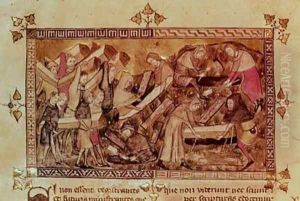Gilles Le Muisit Paintings
Gilles Le Muisit, also known as Aegidius de Murino, was born in 1272 in Tournai, which was part of the County of Hainaut and is now in present-day Belgium. He was not primarily known as an artist in the traditional sense, but rather as an abbot, chronicler, and poet. His contributions to the arts are mainly through his literary works and the historical accounts he left behind, which provide a valuable perspective on the medieval period, particularly the early 14th century.
Le Muisit became the abbot of the Benedictine abbey of St. Martin in Tournai in 1312 and served in that capacity until his death in 1352. During his tenure, he witnessed and documented several significant historical events, including the great famine of 1315-1317, the Battle of Cassel in 1328, and the Black Death, which reached Tournai in 1349. His chronicles offer insights into the social, economic, and religious life of the time.
Apart from his chronicles, Gilles Le Muisit is also known for his poetry, which reflects the spiritual and philosophical concerns of his era. His written works were not only significant for their historical content but also for their stylistic and linguistic qualities, contributing to the development of vernacular literature in the Middle Ages.
Although Gilles Le Muisit did not create visual art himself, the illuminated manuscripts containing his writings are valuable pieces of medieval artistry. These manuscripts are often adorned with elaborate illustrations that provide a glimpse into the visual culture of his time. The preservation of these manuscripts ensures that Le Muisit's work continues to be studied by historians and art historians alike, offering a window into the past through both text and image.
Gilles Le Muisit passed away in 1352, leaving behind a legacy as a significant chronicler of medieval life. His work remains an important source for understanding the complexities and challenges of 14th-century Europe, as well as the intellectual and spiritual life within a Benedictine abbey.
